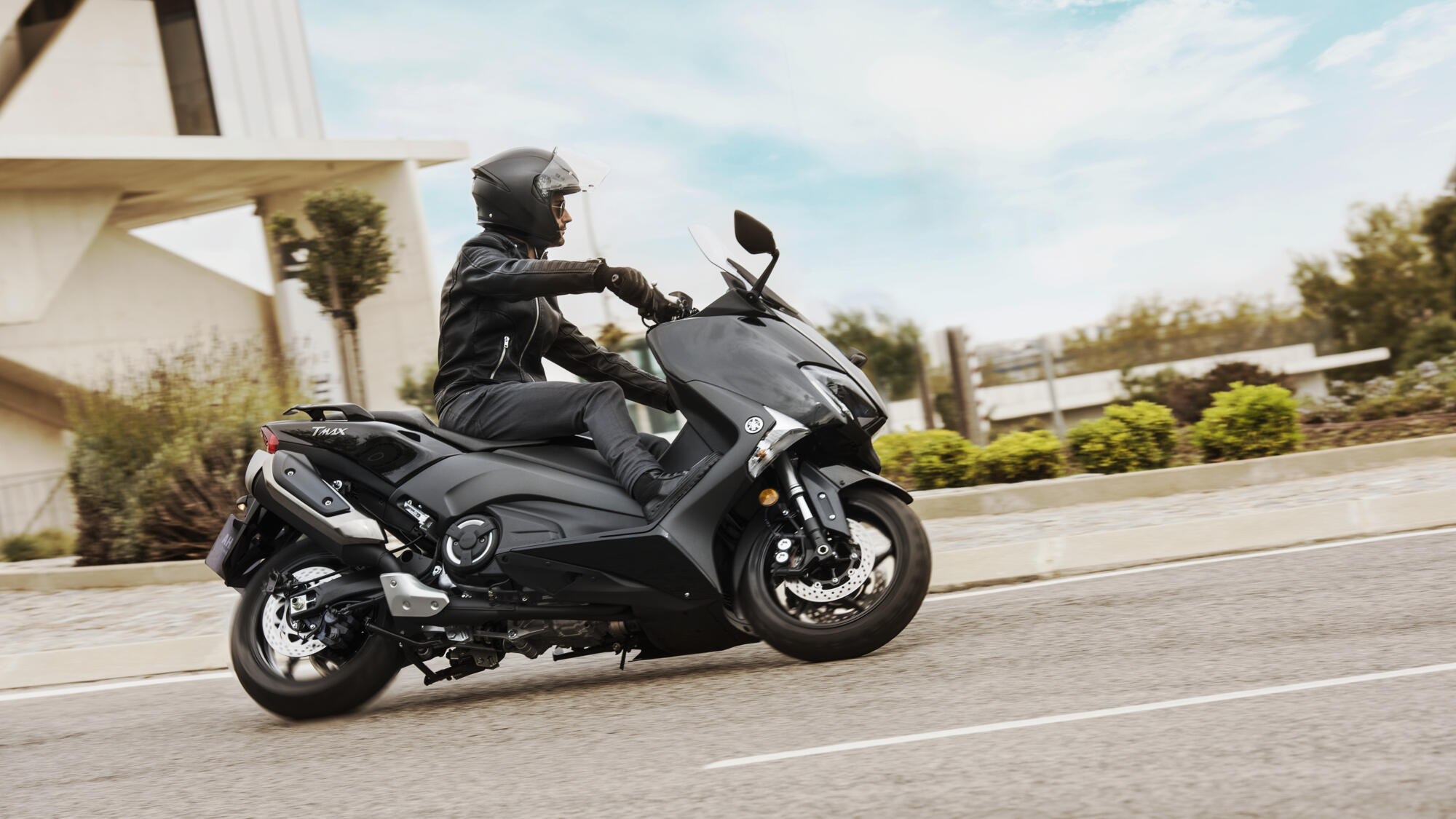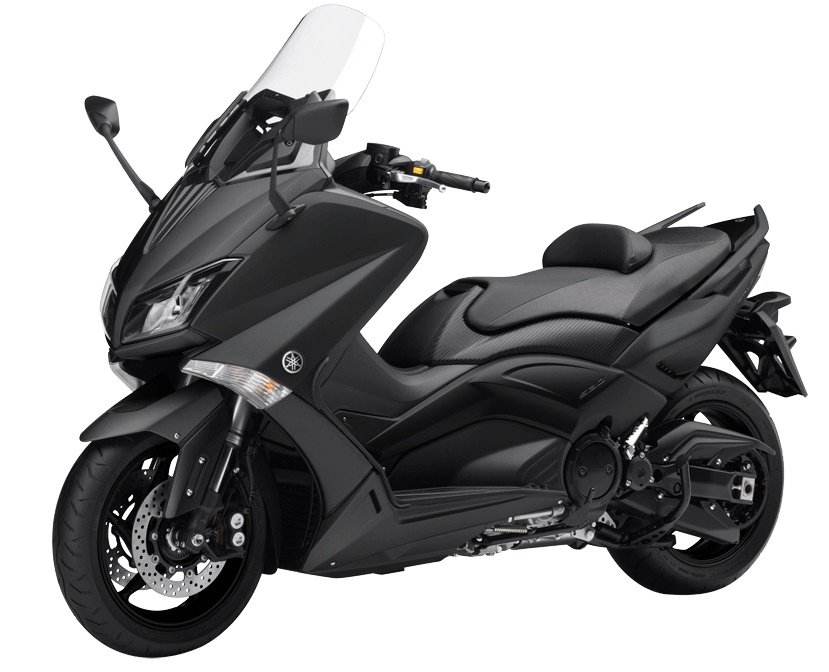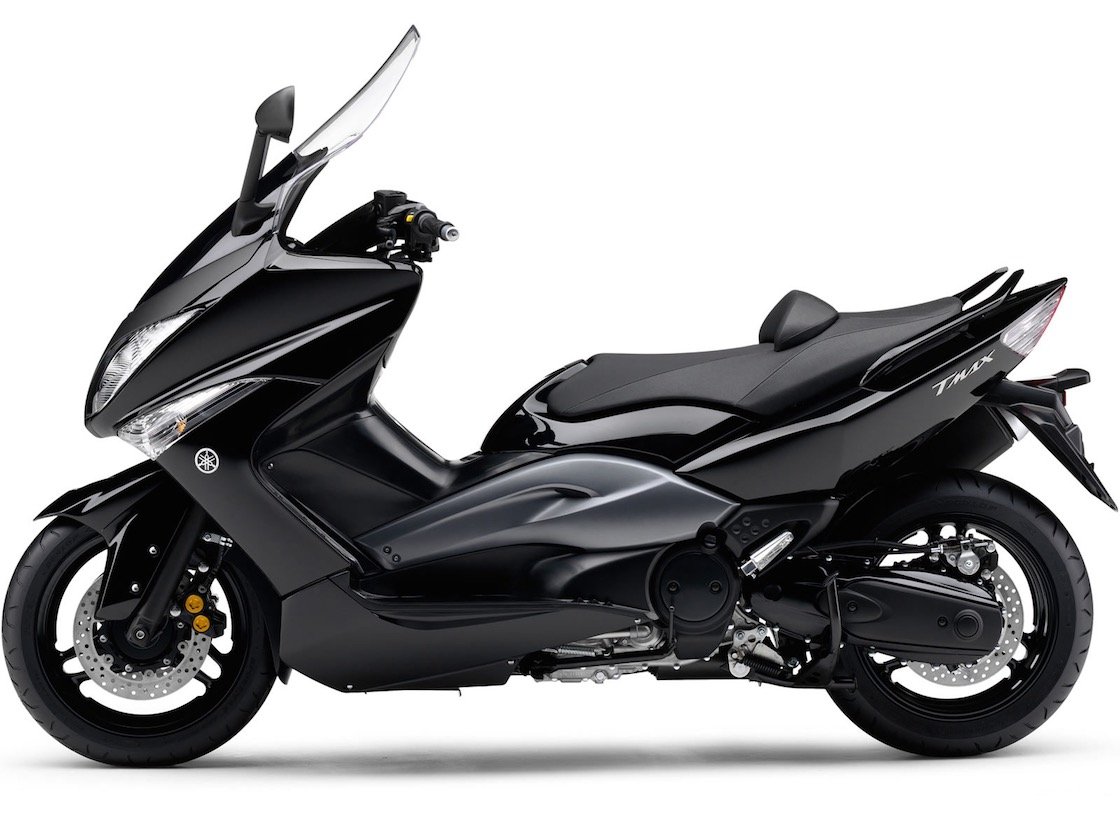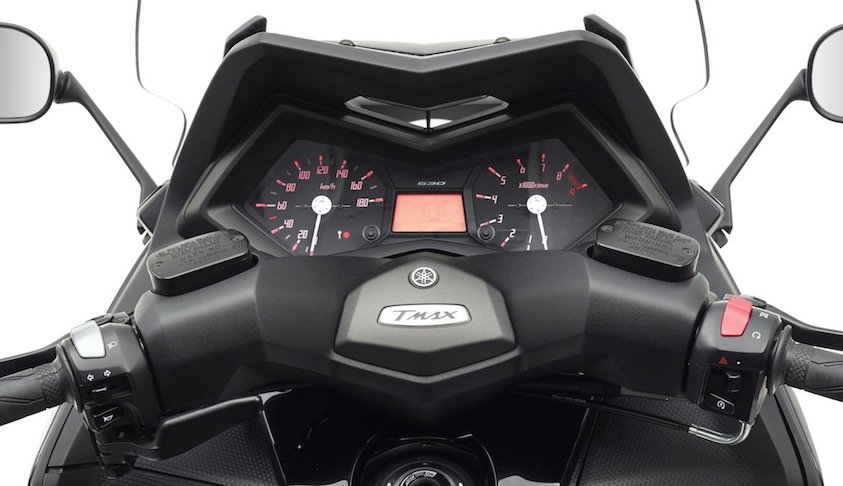YAMAHA TMAX (XP500 / XP530)
With the TMAX, Yamaha mixed what they knew about making sport bikes with the maxiscooter concept to create the sportiest maxi on the market. At 530cc, the TMAX was the largest and fastest scooter Yamaha offered in North America over its 2009 – 2016 run.
The first version of the TMAX (XP500) was offered briefly in the USA (2009 – 2011) before a three year hiatus, after which it returned to the USA for 2015 in revised from as the TMAX 530. That version was offered again in 2016 before being discontinued. In Canada the TMAX has been on sale continually from 2009 to 2016 except 2011, with major updates for both 2012 and 2015 before also being dropped for 2016. Globally Yamaha uses the TMAX name for a range of models up to 750cc, but in North America the name has only been used for this model.
Model Background
The TMAX was originally introduced in Europe for the 2001 model year. This 1st generation maxiscooter was sold from 2001 – 2003, followed by a 2nd generation from 2004 to 2007. It was the third generation of TMAX introduced in Europe for 2008 that arrived in the USA and Canada as a 2009 model.
Since it’s 2009 debut, three notably different versions of the TMAX have been offered in North America. The first version (below) was the 495cc 3rd generation TMAX which lasted three years in the USA (2009 – 2011) and two in Canada (2009 – 2010). After skipping 2011 in Canada, Yamaha introduced the overhauled 2nd version for 2012. This revised TMAX received a 35cc bump to 530cc and gained a slew of updates and new styling. Lastly, Yamaha made less substantial updates for 2015 (shown above) including a restyled front end and tweaks to the handling and amenities.
Version One: 2009 – 2011
The first North American TMAX offered awesome handling and braking. In both of these areas it’s the gold standard for scooters. The die cast aluminum frame and 15” wheels combined with light weight and R6 inspired brakes makes this scooter a blast through the twisties. Unfortunately, Yamaha didn’t squeeze more than average power from the 495cc engine. This TMAX motor does an adequate job for a maxi but it’s not at the same sporty level as the rest of the scooter. Top speed is an impressive 100mph, but it is leisurely about getting there. Hitting 60mph takes 10-11 seconds which means you’ll be battling Corolla’s off the line. For comparison, a 600cc Honda Silverwing accomplishes this feat in about 8 seconds. The acceleration isn’t anemic, but the sports oriented crowd that the TMAX seems to lure might be left wanting. Conversely, the lower power output means this big fuel injected scooter gets above average fuel economy for its size (45mpg). Bigger scooters like the Silverwing and Suzuki Burgman 650 often consume gas at 30 – 40mpg.
Version Two: 2012 – 2014
For 2012 the TMAX received a significant update – and simultaneously got axed from the USA market. The 2012 TMAX wasn’t all new as the frame and core engine are the same, but most aspects of the TMAX were overhauled.
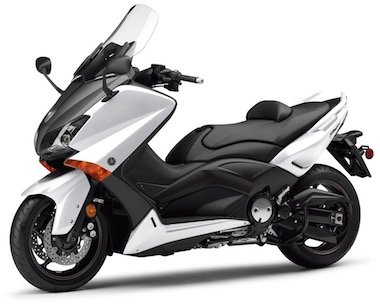
The changes to this motor are so widespread that very few parts can be exchanged between the original TMAX motor and the revised one. The result of these changes is about 10% more torque and it peaks lower at 5250 RPM instead of 6500 RPM. This really improves the former weakest area of the TMAX: mediocre acceleration.
Engine aside, the TMAX gets a host of other upgrades like a redesigned and lighter swingarm that contains a drive belt rather than a higher maintenance chain drive. There’s also a larger rear disc (282mm vs. 267mm), lighter 5 spoke rims and an adjustable windscreen. The new 5 spoke rims are a particularly nice touch. The style of this scooter has also been overhauled with a newly aggressive front end, LED tailight and a more futuristic dash. The new front end style is a bit cluttered but nice.
One result of all of these changes is a 7 lbs weight reduction to 481 lbs. That’s still a lot of scooter, but the increased power, lower RPM torque peak and small weight savings combine into a serious improvement in acceleration and driving enjoyment.
Version Three: 2015 – 2016
For the 2015 model year Yamaha further improved the style and handling of the TMAX and added several new features. Handling was upgraded via a switch to inverted front forks. These new forks are slightly smaller diameter (41mm vs 43mm) and have the same travel (4.7”) but the inverted design reduced unsprung weight and should be more sensitive. Yamaha also switched to a new radially mounted 4 piston caliper for the front brake. The specs are the same as the previous front brake (4 piston caliper, dual 267mm discs) but performance is claimed to be improved.
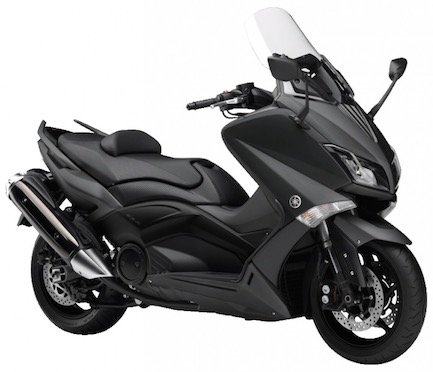
Storage & Convenience
The TMAX is solidly aimed at the maxi-scooter crowd, and thus offers a solid list of features and storage options. The TMAX boasts dual glove boxes – one on each side of the dash, although just the right one makes it to North America. Neither spot is huge, but combined they provide ample storage for your small items like gloves, paperwork, sunglasses and snacks.
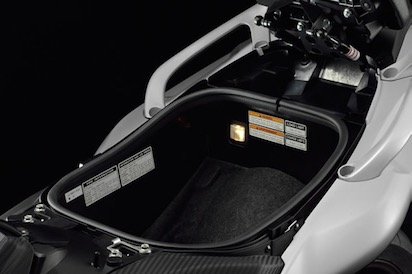
The TMAX offers a bunch of nice features that make touring easy. There’s dual trip odometers, a fuel tripmeter and a clock. 2012 TMAX’s go a step further by adding an ambient air temperature gauge and displaying both your average and instantaneous fuel milage. Other features include a light in the underseat storage area, adjustable drivers backrest, folding mirrors, and an adjustable windscreen on 2012 examples. The 2015 version adds a 12V powered accessory port and remote control of gas cap and storage locks to the features list.
Comparison
The TMAX offered arguably the most sporty styling and performance of the maxi-scooters thus far. It was never a top seller – mostly because most maxiscooter buyers are more interested in touring amenities than sporty performance, but sportier buyers have really loved the TMAX.
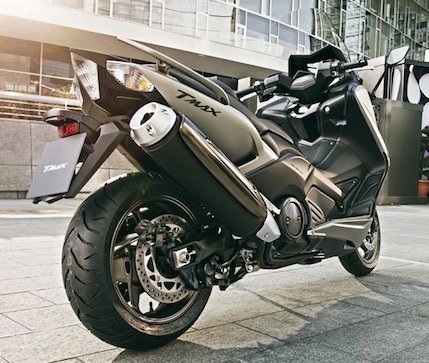
The 500cc maxiscooter segment is less popular segment in North America than the smaller (250-400cc) and larger (600-700cc) maxiscooters. This displacement can be a very nice compromise, but touring oriented or larger riders are likely better off with a bigger machine, while smaller 300-400cc machines shine for around town use with their superior fuel milage and nimble weight. If you ride a blend of touring and daily use the TMAX hits the sweet spot. The main competitor to the TMAX is Kymco’s Xciting 500. The Xciting also offers sporty styling and is quite a bit cheaper, while not offering the same level of technology as the TMAX. Other machines worth cross shopping are Suzuki’s Burgman 400 and maybe some bigger machines like the Burgman 650 and Honda’s Silverwing.
Pros:
- Aluminum Frame
- Dual floating 267mm 4 piston front brake
- Gorgeous 15” rims
- Sporty styling and handling
Cons:
- Lackluster engine (’09 – ’11)
- Ineffective windscreen
Links:
TMAX Service Manual – Great Manual.
MotorscooterGuide Forums – Visit the forum on this site to chat about this scoot.
Nice TMAX Review – Check out this writeup from MotorbikesToday.com
TMAX Review – Great article from TheScooterReview.com
Key Specs:
- Engine: 4-stroke, liquid-cooled, DOHC, 4-valve, parallel twin
- Displacement: 495 cc (pre 2012), 530cc (2012)
- Bore and Stroke: 66 x 73mm / 68 x 73mm (2012)
- Compression Ratio: 11:1 (’09 – ’11), 10.9:1 (’12 – ’16)
- Torque: 34.2 lbs-ft @ 6,500 rpm (’09 – ’11) / 38.3 lbs-ft @ 5250 RPM (’12 – ’16)
- Horsepower: 43hp
- Fuel Delivery: Mikuni 31mm / 34mm fuel injection
- Estimated Fuel Consumption: 50mpg
- Lubrication: Dry Sump
- Ignition: TCI / Electric Start
- Transmission: Fully automatic
- Final Drive: Enclosed chain
- Suspension (Front): 43mm fork or 41mm inverted fork (2015 – present) both with 4.7” travel
- Suspension (Rear): Single shock swingarm, 116mm (4.6″) travel
- Brakes (Front): Dual 267mm discs, 4 piston caliper
- Brakes (Rear): 267mm disc (’09 – ’11) or 282mm Disc (’12 – ’16)
- Tires: 120/70R15 (Front), 160/60R15 (Rear)
- Length: 86.4” / 86.6”
- Width: 30.5”
- Height: 56.9”
- Wheelbase: 62.2”
- Ground Clearance: 4.9″
- Seat Height: 31.5”
- Fuel Capacity: 13 litres (3.3 Gallons)
- Wet Weight: 488lbs (2009 – 2011), 481 lbs (2012 – 2014), 485 lbs (2015 – ’16)
Colors:
- 2009: Dark Metallic Blue, Cadmium Yellow (aka Reddish Yellow)
- 2010: High Tech Silver
- 2011: Raven (USA Only)
- 2012: Bluish White (Canada Only)
- 2013: Matte Metallic Dark Gray (Canada Only)
- 2014: Metallic Brown (Canada Only)
- 2015: Sonic Gray (aka Dark Metallic Gray in Canada)
- 2016: Platinum Gray (aka Matte Light Metallic Gray in Canada)

